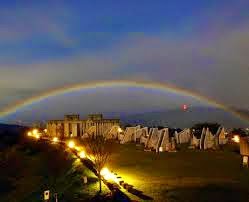Hello, in this time I want to tell you about natural phenomena moonbow. Moonbow is a natural phenomenon that is quite unique because usually rainbow appeared during the daytime while moonbow appears at night, which can be seen from the name "moon" moon usually appears at night. So this is the detail of moonbow.
 |
| A moonbow in the night sky over Takayama, Gunma Prefecture, on Oct. |
A moonbow (also known as a lunar
rainbow, black rainbow, white rainbow, lunar
bow, or space rainbow) is a rainbow produced by light
reflected off the surface of the moon (as opposed to direct sunlight)
refracting off of moisture laden clouds in the atmosphere. Moonbows are
relatively faint, due to the smaller amount of light reflected from the surface
of the moon.
They are always in the opposite part of the sky from the moon.
Because the light is usually too faint to excite the
cone color receptors in human eyes, it is difficult for the human eye to
discern colors in a moonbow. As a result, they often appear to be white. However, the colors in a moonbow do appear in long
exposure photographs.
 |
| Photograph of a real moonbow spanning over castle of Wernigerode, Germany |
By definition, true moonbows are associated with
atmospheric rain events and arise at a time when conditions are optimal in
terms of levels of reflected solar light being reflected from the Moon's
surface. All true moonbows are therefore short-lived and transitory in nature.
True moonbows are independent of all terrestrially fixed geographical features
such as waterfalls etc for their existence.
Moonbows have been mentioned at least since Aristotle's Meteorology (circa 350 BC), and
also in an 1847 publication.
Moonbows are most easily viewed when the moon is at or
nearest to its brightest phase full moon.
For true moonbows to have the greatest prospect of appearing, the moon must be
low in the sky (less than 42 degrees and preferably lower) and the night sky
must be very dark. Since the sky is not completely dark on a rising/setting
full moon, this means they can only be observed 2 to 3 hours before sunrise, (a
time with few observers), or 2 to 3 hours after sunset. And, of course, there
must be rain falling opposite the moon. This combination of requirements makes
moonbows much rarer than rainbows produced by the sun. Moonbows may also be
visible when rain falls during full moonrise at extreme latitudes during the
winter months, when the prevalence of the hours of darkness give more
opportunity for the phenomenon to be observed. One good location for viewing
'true moonbows' is Waimea 'Kamuela', Hawaii Island, Hawaii. Cause this is just a rainbow of course is not dangerous.
Source : http://en.wikipedia.org/wiki/Moonbow
Source : http://en.wikipedia.org/wiki/Moonbow
No comments:
Post a Comment